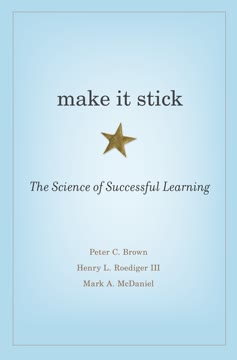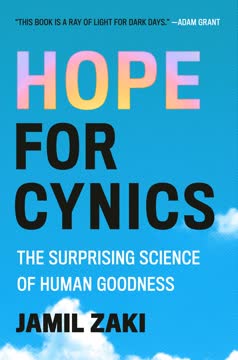つの重要なポイント
1. 学びのプロセスを受け入れる:目的地だけでなく旅路を愛する
野心が失望を招く可能性があるなら、なぜ卓越を追求するのか?
学びの愛。 成功の鍵は、結果に固執するのではなく、学びのプロセス自体に対する真の情熱を育むことにある。このアプローチは、レジリエンス、創造性、そして長期的な成長を促進する。挑戦を改善の機会として受け入れることで、学習者は挫折に直面してもモチベーションと楽しさを維持できる。
成長マインドセット。 知能を固定されたものではなく、変化可能なものと見なす漸進的な理論を採用することが重要である。このマインドセットにより、個人は以下のことができる:
- ミスを学びの機会と見なす
- 障害に直面しても粘り強く取り組む
- 能力を広げるために挑戦を求める
- 建設的なフィードバックに前向きに反応する
自己改善の旅を愛することで、学習者は持続的な卓越を達成し、追求において充実感を見出すことができる。
2. 損失に投資する:挫折を成長の機会に変える
損失への投資は、学びのプロセスに自分を捧げることだ。
不快感を受け入れる。 真に卓越するためには、失敗が予想される挑戦的な状況に自分を置くことが必要である。この意図的な困難への露出は、レジリエンスを築き、スキルの発展を加速させる。損失を将来の成功への投資と再構築することで、学習者は前向きな見通しを維持し、すべての経験から貴重な教訓を引き出すことができる。
成長のための戦略:
- 現在のスキルレベルを少し上回る対戦相手や挑戦を求める
- 失敗を分析して改善点を特定する
- 弱点を繰り返し練習して強みに変える
- 謙虚さとフィードバックへのオープンさを育む
偉大なパフォーマーでさえ、マスタリーへの道で多くの挫折を経験している。損失に投資する意欲が、卓越を達成する者と平凡にとどまる者を分ける。
3. プレゼンスを育む:どんな状況でも深く集中する能力を開発する
どの分野においても、冷静で、現在に集中し、プレッシャーに強い能力が、最高の者と平凡な者を分ける。
精神の明晰さ。 高圧的な状況で集中力と冷静さを維持する能力を開発することは、ピークパフォーマンスにとって重要である。このスキルにより、個人は最も重要な時に自分の全潜在能力を発揮でき、気を散らすものや感情に圧倒されることがない。
プレゼンスを育むための技術:
- 注意力を強化するための定期的な瞑想練習
- 日常生活でのマインドフルネスエクササイズで意識を高める
- レジリエンスを築くために挑戦的な状況に徐々に露出する
- ストレスや不安を管理するための呼吸法
プレゼンスを一貫して鍛えることで、個人はスポーツやビジネス、創造的な追求や人間関係など、あらゆる分野で成功するための強力なツールを開発できる。
4. 小さな円を作る:レパートリーを広げる前に基本をマスターする
深さは幅を凌駕する。なぜなら、それは私たちの隠れた潜在能力の無形で無意識的な創造的要素への道を開くからだ。
深いマスタリー。 広範な技術を表面的に学ぶのではなく、少数の基本原則を徹底的に理解し、内面化することに焦点を当てる。このアプローチにより、これらの基本が第二の天性となるため、より大きな創造性と適応性が可能になる。
小さな円を作るためのステップ:
- 自分の分野での重要な基本スキルや概念を特定する
- これらの要素を詳細に注意を払って繰り返し練習する
- 本質を維持しながら動きやアイデアを徐々に凝縮する
- 一見異なる要素間のつながりを探す
- マスターした原則をますます複雑な状況に適用する
基本要素の深い理解を発展させることで、実践者は革新的な応用と無理のないパフォーマンスを可能にするレベルのマスタリーを達成できる。
5. 逆境を利用する:障害を改善の触媒に変える
最高になりたいなら、他の人が避けるリスクを取り、常にその瞬間の学習の可能性を最適化し、逆境を自分の利点に変える必要がある。
成長マインドセット。 挑戦や挫折を克服できない障害ではなく、成長の機会として捉える。この視点により、個人はモチベーションを維持し、困難な経験から貴重な教訓を引き出すことができる。
逆境を利用するための戦略:
- 挫折を分析して改善点を特定する
- 成長を加速させるために挑戦的な状況を求める
- 怪我や制約を新しいスキルを開発する触媒として利用する
- 否定的な経験を貴重な学習機会として再構築する
逆境を一貫して利点に変えることで、個人はレジリエンス、適応力、そして困難を避ける競争相手とは一線を画す独自のスキルセットを開発できる。
6. 時間を遅くする:深い練習と内面化を通じて知覚を高める
ほぼすべての分野の学生が技術的および心理的なミスを二度と繰り返さないことができれば、その分野のトップに急上昇するだろう。
高まった意識。 意図的な練習とスキルの深い内面化を通じて、個人は自分の分野に対する知覚を高めることができる。これにより、パターンを認識し、挑戦を予測し、経験の浅い実践者よりも迅速かつ正確に意思決定を行うことができる。
時間を遅くするための技術:
- 複雑なスキルを小さな要素に分解して集中練習する
- 詳細にシナリオを心の中でリハーサルするための視覚化を使用する
- パターンと原則の豊かな精神的枠組みを開発する
- ますます挑戦的で現実的な条件で練習する
スキルがより深く内面化されると、実践者は時間が遅く感じられるフロー状態にアクセスでき、高圧的な状況でのピークパフォーマンスを可能にする。
7. トリガーを作る:ピークパフォーマンスに一貫してアクセスするためのルーチンを作成する
秘密は、常にすべてがかかっているということだ。練習で現在に集中すればするほど、競技、会議、試験、手術台、大舞台での集中力も高まる。
一貫した卓越性。 最適な集中力と準備状態を確実に引き出す個別の事前パフォーマンスルーチンを開発する。このルーチンは、どんな状況でも迅速にピーク精神状態にアクセスできるように徐々に凝縮することができる。
トリガーを作るためのステップ:
- 一貫してフロー状態に入る活動を特定する
- これらの活動を中心に複数のステップからなるルーチンを作成する
- パフォーマンスや挑戦の前に定期的にルーチンを練習する
- 効果を維持しながらルーチンを徐々に凝縮する
- 最小限の外部キューでトリガー状態にアクセスする方法を学ぶ
ピークパフォーマンスのための信頼できるトリガーを開発することで、個人は高圧的または予期しない状況でも一貫して最高の能力にアクセスできる。
8. 感情をチャネルする:怒りのような感情を集中力と創造力の燃料にする
無意識にいじめられたり否定したりするのではなく、これらのプレイヤーは内なる動きを火に味付けする。
感情の知性。 感情を抑えたり制御されたりするのではなく、認識し生産的にチャネルする方法を学ぶ。このアプローチにより、個人は冷静さを保ちながら、感情が提供する高まったエネルギーと集中力にアクセスできる。
感情をチャネルするための技術:
- 感情状態の意識を高めるためのマインドフルネスを練習する
- 異なる感情を再チャネルするための具体的な戦略を開発する
- 挑戦的な状況での感情制御をリハーサルするための視覚化を使用する
- 否定的な感情をエネルギーとモチベーションの源として再構築する
感情をチャネルする能力をマスターすることで、実践者は感情的に充実した状況でもピークパフォーマンスを維持し、潜在的な気を散らす要素を強力な資産に変えることができる。
9. 混乱の中で柔軟さを保つ:柔軟性を通じてレジリエンスを開発する
不完全さに満足していれば、外部の批判に揺さぶられることはない。
適応力。 予期しない挑戦や気を散らすものに直面しても、冷静さと集中力を保つ能力を育む。この「柔らかい」アプローチは、硬直した、柔軟性のないマインドセットと比較して、より大きなレジリエンスと適応力を可能にする。
柔軟さを保つための戦略:
- 気を散らすものに対する非反応性を開発するための瞑想を練習する
- ますます混沌とした環境に徐々に露出する
- 挑戦を機会と見なす成長マインドセットを開発する
- 外部の条件に関係なく、内なる静けさと集中力を見つける方法を学ぶ
この内なる安定性を開発することで、実践者は非常に予測不可能またはストレスの多い状況でもピークパフォーマンスを維持し、潜在的な障害を成長と成功の機会に変えることができる。
最終更新日:
FAQ
What's The Art of Learning about?
- Personal Journey of Mastery: The book follows Josh Waitzkin's transformation from a chess prodigy to a martial arts champion, exploring the principles of learning and performance across disciplines.
- Integration of Disciplines: Waitzkin highlights the interconnectedness of chess and Tai Chi, showing how skills in one area can enhance performance in another.
- Philosophical and Psychological Insights: The narrative is enriched with reflections from Taoist and Buddhist traditions, offering insights into learning, personal growth, and handling competitive pressures.
Why should I read The Art of Learning?
- Practical Learning Techniques: Waitzkin provides methods for mastering any skill, making the book relevant for personal and professional growth.
- Inspiration from a Prodigy: His journey offers a unique perspective on competition and excellence, inspiring readers to embrace challenges.
- Mindfulness and Presence: The book emphasizes the importance of being present and mindful, applicable beyond sports or games.
What are the key takeaways of The Art of Learning?
- Investment in Loss: Emphasizes learning from failures as stepping stones to success, fostering resilience and a growth mindset.
- Beginner’s Mind: Advocates for openness and adaptability in learning, essential for continuous growth.
- Incremental Learning Approach: Focuses on breaking down complex skills into manageable parts for deeper understanding and mastery.
What are the best quotes from The Art of Learning and what do they mean?
- "One has to investigate the principle in one thing or one event exhaustively.": Stresses the importance of deep understanding in any discipline for mastery.
- "Investment in loss is giving yourself to the learning process.": Encourages embracing failure as a crucial part of growth.
- "Great ones are willing to get burned time and again as they sharpen their swords in the fire.": Highlights the necessity of embracing failure and discomfort in the learning process.
How does Josh Waitzkin connect chess and Tai Chi in The Art of Learning?
- Shared Principles: Both require strategic thinking and deep mental engagement, illustrating the transference of skills across disciplines.
- Mindfulness and Presence: Emphasizes being present and aware, enhancing performance and decision-making under pressure.
- Skill Transference: Demonstrates how insights from one discipline can enrich learning in another.
What is the "Investment in Loss" concept in The Art of Learning?
- Learning from Failures: Encourages viewing losses as essential components of the learning process rather than setbacks.
- Psychological Resilience: Develops resilience and a growth mindset, crucial for long-term success.
- Practical Application: Illustrated through Waitzkin's experiences in chess and Tai Chi, showing how each loss leads to deeper insights.
What is the "Soft Zone" and its significance in The Art of Learning?
- Definition of the Soft Zone: A state of relaxed focus allowing full engagement without tension or anxiety.
- Performance Enhancement: Facilitates creativity and adaptability, enabling effective responses to challenges.
- Practical Techniques: Includes mindfulness practices and breathing techniques for achieving this state in high-pressure situations.
How does The Art of Learning address the role of emotions in performance?
- Emotional Awareness: Recognizing and understanding emotions enhances performance rather than suppressing them.
- Channeling Emotions: Uses emotions like anger and excitement as sources of energy and motivation.
- Practical Techniques: Offers strategies like breathing exercises and visualization to manage emotions during competition.
What is the "Making Smaller Circles" method in The Art of Learning?
- Focus on Fundamentals: Involves honing in on essential principles by practicing small, specific movements or techniques.
- Incremental Refinement: Enhances overall performance by mastering small details, leading to success in broader contexts.
- Application Across Disciplines: Demonstrates how this method applies to both chess and martial arts.
How does Josh Waitzkin handle adversity in The Art of Learning?
- Using Adversity as Fuel: Transforms challenges into opportunities for growth, deepening resolve and improving skills.
- Psychological Resilience: Maintains a positive mindset, thriving under pressure rather than succumbing to fear.
- Practical Strategies: Provides advice on cultivating resilience, such as visualization techniques and stress-recovery practices.
What is the "Internal Solution" concept in The Art of Learning?
- Creating Inspiring Conditions: Cultivates an internal state for optimal performance, regardless of external circumstances.
- Harnessing Adversity: Internalizes lessons from challenges, drawing on insights in future situations.
- Mind-Body Connection: Integrates mental and physical training to enhance performance and resilience.
How does The Art of Learning suggest building a personal routine for peak performance?
- Identifying Triggers: Encourages discovering activities that induce focus and calm, incorporating them into a pre-performance routine.
- Creating a Structured Routine: Develops a routine with elements like meditation, physical warm-ups, and visualization.
- Flexibility and Adaptation: Stresses the importance of adapting the routine to different situations for effectiveness.
レビュー
本書『The Art of Learning』は賛否両論の評価を受けている。多くの人々は、チェスの天才であり武道のチャンピオンであるワイツキンの高いレベルのパフォーマンスと学習に関する洞察を称賛し、彼の独自の視点を評価している。読者は、漸進的な成長、広さよりも深さ、そして存在感の育成という彼の概念に価値を見出している。しかし、一部の人々はこの本を実践的なガイドというよりも回顧録と捉え、具体的なアドバイスが不足していると感じている。また、ワイツキンの語り口が自己顕示的だと批判する声もある。全体として、この本はマスタリーと最高のパフォーマンスに興味がある人々にとっては刺激的な内容であるが、その魅力は読者の期待によって異なるかもしれない。
Similar Books














